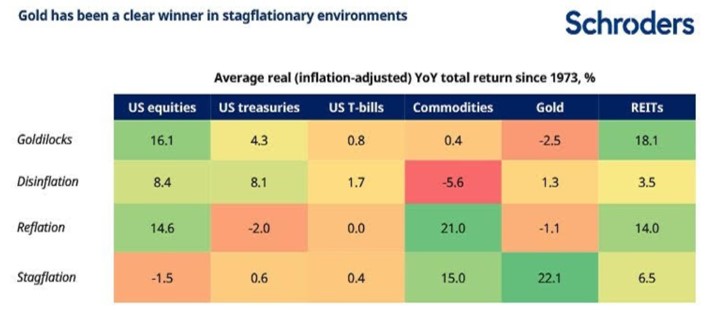Wealth Strategies
What Investments Makes Sense If "Stagflation" Hits - Schroders

The wealth and investment management house crunches the data to work out the kind of assets that offer most protection if "stagflation" comes back like a bad dream from the 1970s.
The ugly word “stagflation” – mixing stagnation and inflation –
is like a bad dream returning as economists and investors fret
that rising prices pressures will overlap flagging growth. And,
if this scenario plays out, they also want to know what it will
mean for asset allocation?
Strategists at Schroders, the UK-listed
firm, think that if stagflation becomes reality it should be good
news for gold and other “defensive assets.”
Gold has often performed well in stagflation environments. For
example, Schroders crunched data and found that the top
performers during periods of stagflation have been gold (+22.1
per cent), commodities (+15.0 per cent) and real estate
investment trusts (REITs) (+6.5 per cent). Equities, however,
have tended to struggle (-1.5 per cent).
“This makes sense. Gold is often seen as a safe-haven asset and
so tends to appreciate in times of economic uncertainty. Real
interest rates also tend to decline in periods of stagflation as
inflation expectations rise and growth expectations fall. Lower
real rates reduce the opportunity cost of owning a zero-yielding
asset such as gold, thereby boosting its appeal to investors,”
Sean Markowicz, CFA, strategist, research and analytics, says in
a recent note.
His comments come as wealth management houses set out forecasts
for 2022 and guides on asset allocation. Developed countries’
equities rose robustly in 2021, although Asian equities and those
in emerging markets have lagged. Citigroup has predicted
continued equity gains next year, albeit modest. The first half
of 2021 saw a strong rebound in economic growth alongside rising
inflation, but it appears that growth momentum is slowing. Fiscal
and monetary boosters are fading – governments’ budgets are
already stretched and it is worth remembering that in much of the
developed world, central bank interest rates have been very low,
or even negative. Inflation is elevated as a result of
supply-chain snags and surging energy costs. (It is also possible
that large central bank money printing may have added to
inflation.)
The Schroders note came out a day before UK official data showed
consumer price inflation rose 5.1 per cent in November. In the
US, producer price data rose 9.6 per cent in that month from
a year ago.
“Taken together, concerns are brewing that a stagflationary
environment – one of low growth but high inflation – may be
unfolding,” Markowicz said.

Source: Schroders
Gold’s safe-haven status is a value, while commodities (raw
materials and energy, etc) are a source of input costs for
companies as well as a key component of inflation indices. So,
they will typically perform well when inflation rises too (often
because they are the cause of the rise in inflation), he said. He
said REITs offer a partial inflation hedge via the pass-through
of price increases in rental contracts and property prices.
Analysis of US Treasuries shows that they offer uncertain
benefits. “In theory, they should benefit from falling real
rates, driven by declining growth. However, rising inflation eats
into their income, putting upward pressure on yields and downward
pressure on prices,” he said.
